The well-being of our children is a barometer for the future.
A healthy start begins with the prenatal health and well-being of a child’s mother, and includes a child’s early months and years, when a child’s brain is rapidly developing the knowledge and skills essential for future success in their relationships, school, and reaching their full potential in life. The economic security and stability of young families is critical during this time, as it reduces the risk of poverty and stress to parents and children—which can have lifelong impacts on the whole family’s well-being, even when experienced for a short period of time. A high quality early learning system can support young families by providing children with learning environments that support healthy development, and giving parents affordable options for child care so they can work if they need or wish to.
- Percentage of Low Birthweight Babies
- Percentage of Children Age Birth to Five Living Above 200% of the Federal Poverty Line
- Cost & Availability of Child Care
Percentage of Low Birthweight Babies
Why is this indicator important?
Compared to babies born at a healthy weight, babies born at low birthweight (less than 2,500 grams, or five and a half pounds) are at greater risk of dying in the first year of life and experiencing a host of health issues as they age, including physical disabilities and impaired physical, social, and emotional development. The percentage of low birthweight babies is one of our earliest indications of the well-being of future generations.
How is Washington state doing?
Washington state has one of the lowest overall rates of low birthweight in the country, ranking fourth best out of the fifty states. The rate has effectively remained unchanged for the past ten years, hovering just over 6 percent (Chart 1.1). Babies of color—for every racial and ethnic group for which we have data—have rates of low birthweight higher than the state average (Chart 1.2), and there is significant variation by county (Chart 1.3), with the lowest rate being in Jefferson County (2.7 percent) and the highest being in Columbia County (18.4 percent).
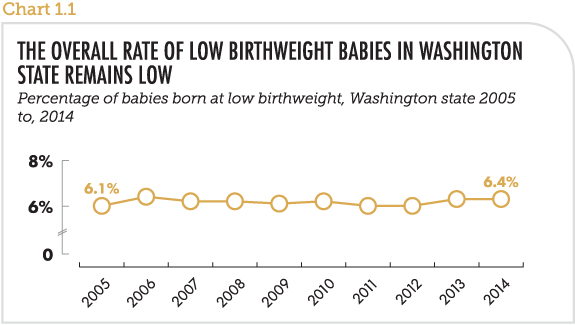
Sources: Center for Health Statistics, Washington State Department of Health (DOH), Infant Birth Tables.
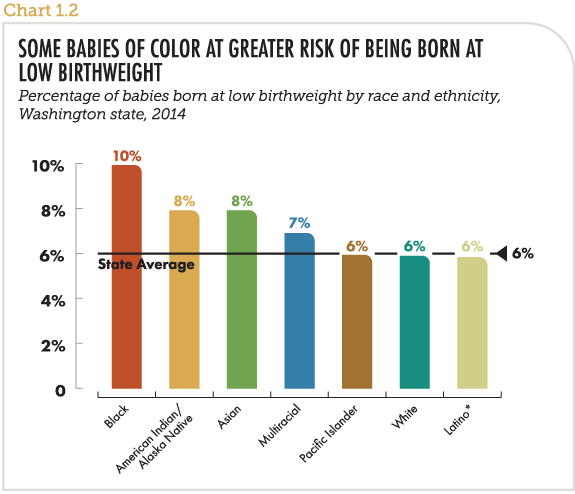
Sources: Center for Health Statistics, DOH, Infant Birth Tables. *Population Reference Bureau analysis of National Center for Health Statistics (NCHS).

Sources: Center for Health Statistics, DOH, Infant Birth Tables.
Percentage of Children Age Birth to Five Living Above 200% of the Federal Poverty Line
Why is this indicator important?
One of the most resource-intensive periods parents experience is when their children are between the ages of birth and five. Babies and toddlers require significant investment—physically, mentally, emotionally, and financially—making families with young children particularly vulnerable to stress. When parents have what they need to ensure the basic needs of their families are met, it maximizes the quality of time they can spend with their children and minimizes stress overall. The percentage of children under the age of six who are living above 200 percent of the federal poverty line ($40,320 for a family of three) is an important indicator of the future health and well-being of families, as well as that of the state.
How is Washington state doing?
The share of children living in economically secure families has declined in recent years, dropping to 58 percent in 2014 from 61 percent in 2008 (Chart 2.1). Rates of economic security vary considerably by race and ethnicity, with Black, Latino, and American Indian/Alaska Native children having the least economic security among their peers (Chart 2.2). Children from rural counties in Washington state also have low rates of economic security compared to children living in more urban areas—at 69 percent, King County has the highest rates of child economic security, compared to just 26 percent in Adams County (Chart 2.3).
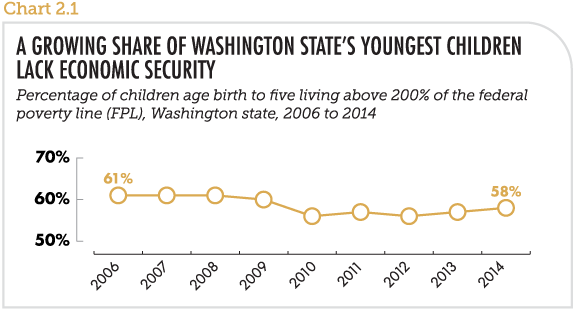
Sources: Budget & Policy Center (B&PC) analysis of 2006 to 2014 American Community Survey data.
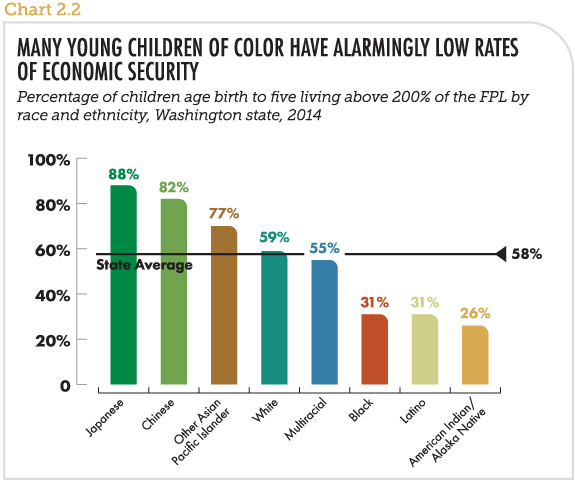
Sources: B&PC analysis of Integrated Public Use Microdata Series (IPUMS) 2010-2014 5-year American Community Survey data.

Sources: B&PC analysis of Integrated Public Use Microdata Series (IPUMS) 2010-2014 5-year American Community Survey data.
Cost & Availability of Child Care
Why is this indicator important?
High quality, affordable child care is critical to child and family well-being for two reasons: (1) It provides children with experiences that promote their physical, social, and emotional development; and (2) It supports working parents by giving them the peace of mind that their children are safe and well-cared for while they work.
How is Washington state doing?
Six of every ten (60 percent) children under age six in Washington state live in families where all parents are working (Chart 3.1). For every ten children under age six in Washington state, the average number of family child care or center slots available is five. In all but two counties (Garfield and Whitman), the number of child care slots available is less than the number of children potentially in need of care (Chart 3.3), and care for infants is especially lacking in most areas of the state.
Even if there were enough slots available, however, the cost of child care remains prohibitive for many families. The average cost of care for an infant and toddler in Washington state is nearly $22,000 annually. Families of color tend to pay a disproportionately greater share—as much as 58 percent—of their income (Chart 3.2). For reference, “affordable” child care is defined as costing no more than 10 percent of family income.1
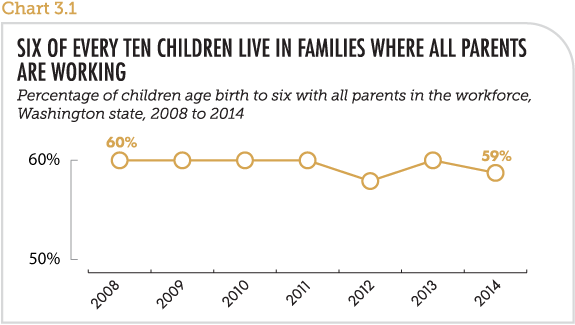
Sources: Population Reference Bureau, analysis of data from the U.S. Census Bureau, 2008 – 2014 American Community Survey.

Sources: Child Care Aware of Washington; median cost of care per month for one infant and one toddler is $1,820. Median income taken from 2014 American Community Survey Tables B19013A-I.
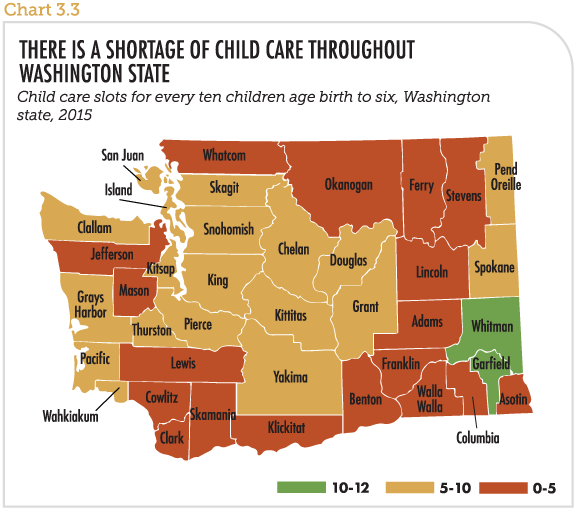
Sources: Child Care Aware of Washington and B&PC analysis of 2014 American Community Survey data.
Up Next
Goal: All young children have their basic needs met.
- White House (2014) .




